I used to work on “non-convex” regularization with -penalties, that is, studying the Tikhonov functional
The regularization properties are quite nice as shown by Markus Grasmair in his two papers “Well-posedness and convergence rates for sparse regularization with sublinear penalty term” and “Non-convex sparse regularisation” and by Kristian Bredies and myself in “Regularization with non-convex separable constraints”.
The next important issue is to have some way to calculate global minimizers for (1). But, well, this task may be hard, if not hopeless. Of course one expects a whole lot of local minimizers.
It is quite instructive to consider the simple case in which is the identity first:
Example 1 Consider the minimization of
This problem separates over the coordinates and hence, can be solved by solving the one-dimensional minimization problem
- For
we get
.
- Replacing
by
leads to
instead of
.
Hence, we can reduce the problem to: For
find
One local minimizer is always
since the growth of the
-th power beats the term
. Then, for
large enough, there are two more extrema for~(4) which are given as the solutions to
one of which is a local maximum (the one which is smaller in magnitude) and the other is a local minimum (the one which is larger in magnitude). This is illustrated in the following “bifurcation” picture:
Now the challenge is, to find out which local minimum has the smaller value. And here a strange thing happens: The “switching point” for
at which the global minimizer jumps from
to the upper branch of the (multivalued) inverse of
is not at the place at which the second local minimum occurs. It is a little bit larger: In “Convergence rates and source conditions for Tikhonov regularization with sparsity constraints” I calculated this “jumping point” the as the weird expression
This leads to the following picture of the mapping
1. Iterative re-weighting
One approach to calculate minimizers in~(1) is the so called iterative re-weighting, which appeared at least in “An unconstrained minimization for sparse solution of under determined linear systems” by Ming-Jun Lai and Jingyue Wang but is probably older. I think for the problem with equality constraints
the approach at least dates back to the 80s but I forgot the reference… For the minimization of (1) the approach goes as follows: For choose a
and a small
and rewrite the
-quasi-norm as
The necessary condition for a minimizer of
is (formally take the derivative)
Note that the exponent is negative (which is also a reason for the introduction of the small
). Aiming at an iteration, we fix some of the
‘s and try to solve for others: If we have a current iterate
we try to find
by solving
for . This is the necessary condition for another minimization problem which involves a weighted
-norm: Define (non-negative) weights
an iterate
Lai and Wang do this for which has the benefit that each iteration can be done by solving a linear system. However, for general
each iteration is still a convex minimization problem. The paper “Convergence of Reweighted
Minimization Algorithms and Unique Solution of Truncated
Minimization” by Xiaojun Chen and Weijun Zhou uses
and both papers deliver some theoretical results of the iteration. Indeed in both cases one can show (subsequential) convergence to a critical point.
Of course the question arises if there is a chance that the limit will be a global minimizer. Unfortunately this is not probable as a simple numerical experiment shows:
Example 2 We apply the iteration (5) to the one dimensional problem (3) in which we know the solution. We do this for many values of
and plot the value of
against the limit of the iteration. Good news first: Everything converges nicely to critical points as expected. Even better:
can be really small–machine precision works. The bad news: The limit depends on the initial value. Even worse: The method frequently ends on “the wrong branch”, i.e. in the local minimum which is not global. I made the following experiment: I took
, set
and chose
. First I initialized for all values of
with
. This produced the following output (I plotted every fifth iteration):
Well, the iteration always chose the upper branch… In a second experiment I initialized with a smaller value, namely withfor all
. This gave:
That’s interesting: I ended at the upper branch for all values below the point where the lower branch (the one with the local maximum) crosses the initialization line. This seems to be true in general. Starting with
gave
Well, probably this is not too interesting: Starting “below the local maximum” will bring you to the local minimum which is lower and vice versa. Indeed Lai and Wang proved in their Theorem 2.5 that for a specific setting (of completely full rank, sparsity high enough) there is an
small enough such that the method will pick the global minimizer. But wait—they do not say anything about initialization… What happens if we initialize with zero? I have to check…
By the way: A similar experiment as in this example with different values of showed the same behavior (getting the right branch if the initialization is ok). However: smaller
gave much faster convergence. But remember: For
(experimentally the fastest) each iteration is an
penalized problem while for
one has to solve a linear system. So there seems to be a tradeoff between “small number of iterations in IRLP” and “complexity of the subproblems”.
2. Iterative thresholding
Together with Kristian Bredies I developed another approach to these nasty non-convex minimization problems with -quasi-norms. We wrote a preprint back in 2009 which is currently under revision. Moreover, we always worked in a Hilbert space setting that is
maps the sequence space
into a separable Hilbert space.
Remark 1 When showing results for problems in separable Hilbert space I sometimes get the impression that others think this is somehow pointless since in the end one always works with
in practice. However, I think that working directly in a separable Hilbert space is preferable since then one can be sure that the results will not depend on the dimension
in any nasty way.
Basically our approach was, to use one of the most popular approaches to the -penalized problem: Iterative thresholding aka forward-backward splitting aka generalized gradient projection. I prefer the last motivation: Consider the minimization of a smooth function
over a convex set
by the projected gradient method. That is: do a gradient step and use the projection to project back onto
:
Now note that the projection is characterized by
Now we replace the “convex constraint” by a penalty function
, i.e. we want to solve
Then, we just replace the minimization problem for the projection with
and iterate
The crucial thing is, that one needs global minimizers to obtain . However, for these
penalties with
these are available as we have seem in Example~1. Hence, the algorithm can be applied in the case
One easily proves that one gets descent of the objective functional:
Lemma 1 Let
be weakly lower semicontinuous and differentiable with Lipschitz continuous gradient
with Lipschitz constant
and let
be weakly lower semicontinuous and coercive. Furthermore let
denote any solution of
Then for
it holds that
Proof: Start with the minimizing property
and conclude (by rearranging, expanding the norm-square, canceling terms and adding to both sides) that
Finally, use Lipschitz-continuity of to conclude
This gives descent of the functional value as long as . Now starts the hard part of the investigation: Under what circumstances do we get convergence and what are possible limits?
To make a long story short: For -penalties (and also other non-convex penalties which leave the origin with infinite slope) and fixed step-size
one gets that every subsequence of the iterates has a strong accumulation point which is a fixed point of the iteration for that particular
as long as
. Well that’s good, but here’s the bad news: As long as
we do not obtain the global minimizer. That’s for sure: Consider
and any
…
However, with considerably more effort one can show the following: For the iteration with
(and another technical condition on the Lipschitz constant of
) the iterates have a strong accumulation point which is a solution
and hence, satisfies necessary conditions for a global minimizer.
That’s not too bad yet. Currently Kristian and I, together with Stefan Reiterer, work to show that the whole sequence of iterates converges. Funny enough: This seems to be true for and
with rational
in
… Basically, Stefan was able to show this with the help of Gröbner bases and this has been my first contact with this nice theory. We hope to finalize our revision soon.
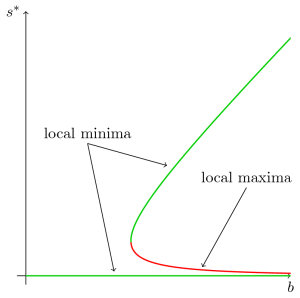
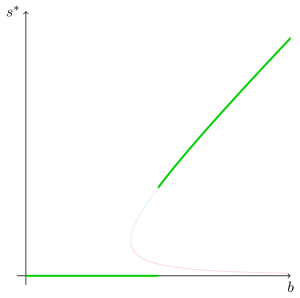
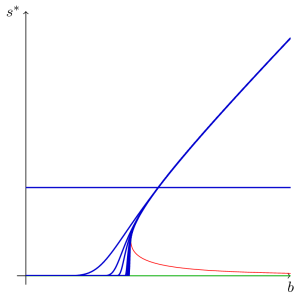
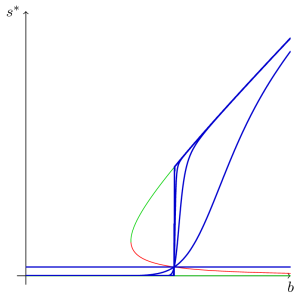
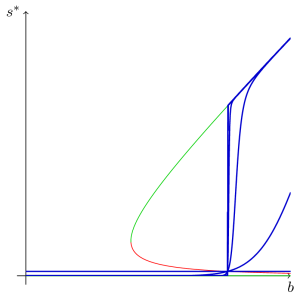
August 25, 2012 at 9:42 pm
[…] correctly, she also treated “iteratively reweighted least squares” as I described in my previous post. Unfortunately, she did not include the generalized forward-backward methods based on -functions […]